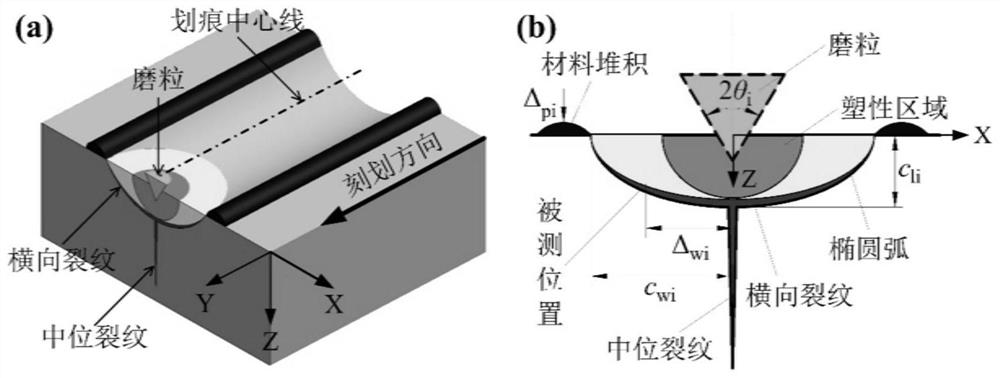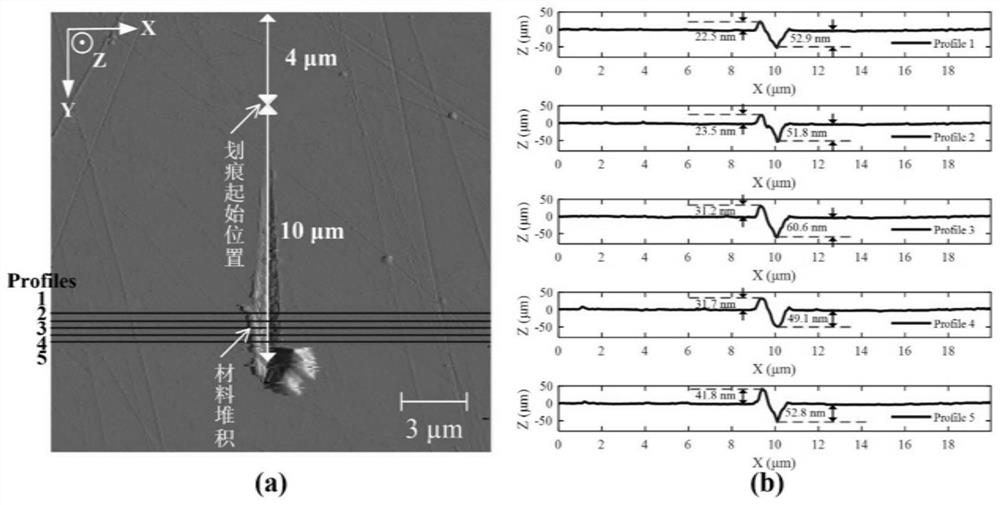Image processing-based method for predicting wire roughness of whole surface of monocrystalline silicon wafer cut by fretsaw
A monocrystalline silicon wafer and image processing technology, applied in the field of mechanical processing and manufacturing, can solve the problems of reducing the duration of minority carriers, increasing manufacturing costs, surface/subsurface damage, etc., and achieve the effect of shortening the time of manual measurement
- Summary
- Abstract
- Description
- Claims
- Application Information
AI Technical Summary
Problems solved by technology
Method used
Image
Examples
Embodiment 1
[0045] see Figure 1 to Figure 6 , an image processing-based method for predicting the full surface line roughness of a single crystal silicon wafer cut by a wire saw, comprising the following steps:
[0046] 1) Establish a mathematical relationship model between the full surface line roughness of a single crystal silicon wafer and the width of the pit. The pits are formed by removing the material above the lateral cracks of the single crystal silicon wafer.
[0047] The whole surface line roughness of the single crystal silicon wafer includes the roughness perpendicular to the crack and the roughness parallel to the crack direction.
[0048] The mathematical relationship model between the full surface line roughness of the single crystal silicon wafer and the width of the pit includes a roughness calculation model perpendicular to the crack and a roughness calculation model parallel to the crack direction.
[0049] The roughness calculation model perpendicular to the crack ...
Embodiment 2
[0075] A method for predicting the full surface line roughness of a single crystal silicon wafer cut by a wire saw based on image processing, the steps are as follows:
[0076] (1) Considering the scratch direction and material accumulation effect on the surface of the silicon wafer, a mathematical relationship model between the full surface line roughness of the single crystal silicon wafer and the width of the pit is established.
[0077] (2) Carry out nano-scribing experiments on the surface of silicon wafers, measure the material stacking heights on both sides of the scratches, and bring them into the mathematical relationship model between the overall surface line roughness and pit width of single-crystal silicon wafers.
[0078] (3) Obtain the microscopic surface morphology of the tested single crystal silicon wafer, measure the maximum pit width and depth, and solve the unknown quantity in the mathematical relationship model between the full surface line roughness of the...
Embodiment 3
[0099] An experiment based on image processing of wire saw cutting single crystal silicon wafer full surface line roughness prediction method, the content is as follows:
[0100] 1. Experiment object:
[0101] Take the single crystal silicon wafer processed by the diamond wire saw cutting machine (QPJ1665) produced by Dalian Liancheng CNC Machine Co., Ltd. as an example. The characteristics of the silicon wafer material are: density ρ=2.33 g / cm 3 , Young's modulus E=129.5GPa, Poisson's ratio ν=0.24, hardness H=11.0GPa, fracture toughness The size of the silicon wafer is: length×width×height=156×156×0.2mm. The sawing wire parameters are: sawing wire diameter D=86.9μm, sawing wire core diameter d=74.4μm, abrasive particle diameter d m =12μm, the height H of abrasive grains m =5.4μm, abrasive grain density N=424 / mm 2 . The process parameters are: wire feed speed v f =1.5mm / min, saw wire speed v s = 1800 m / min.
[0102] 2. Experimental process:
[0103] (1) Considering ...
PUM
| Property | Measurement | Unit |
|---|---|---|
| density | aaaaa | aaaaa |
| hardness | aaaaa | aaaaa |
| Poisson's ratio | aaaaa | aaaaa |
Abstract
Description
Claims
Application Information
 Login to View More
Login to View More - Generate Ideas
- Intellectual Property
- Life Sciences
- Materials
- Tech Scout
- Unparalleled Data Quality
- Higher Quality Content
- 60% Fewer Hallucinations
Browse by: Latest US Patents, China's latest patents, Technical Efficacy Thesaurus, Application Domain, Technology Topic, Popular Technical Reports.
© 2025 PatSnap. All rights reserved.Legal|Privacy policy|Modern Slavery Act Transparency Statement|Sitemap|About US| Contact US: help@patsnap.com



